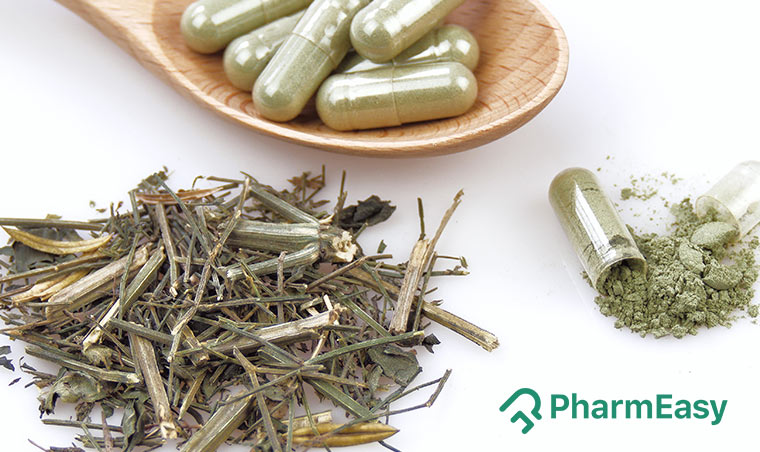Kalmegh: Uses, Benefits, Side Effects, Precautions & More!
By Dr Anuja Bodhare +2 more

Get,

to manage your symptom
Get your,


4 Cr+ families
benefitted

OTP sent to 9988776655



You’ve successfully subscribed to receive
doctor-approved tips on
Whatsapp

Get ready to feel your best.

Hi There,
Download the PharmEasy App now!!


Register to Avail the Offer
Send OTPBy continuing, you agree with our Privacy Policy and Terms and Conditions

Hi There,
Sign up on PharmEasy now!!
Trusted by 4 crore+ families

OTP sent to 9988776655



You have unlocked 25% off on medicines




Code: NU25
By Dr Anuja Bodhare +2 more
Table of Contents
Andrographis paniculata (Burm.f.) Nees is known as kalmegh in Hindi. It is known to be an important native crop of India and Srilanka1.
Kalmegh is also called ‘BhuiNeem’ as it looks very similar to neem and, though smaller, has a bitter taste. Kalmegh is an erect herb that grows annually. It is used as a wonder drug in tribal medicine and in Indian Siddha, ayurvedic systems of medicine2,4.

Kalmegh is an important herb for its benefits for health, as it acts by inducing enzymes. Kalmegh’s potential beneficial properties are as follows1:
Indian systems of medicine, including Ayurveda, have been using the plant for its potential health benefits since ancient times. In countries like China, India, and other south-east Asian countries, kalmegh is traditionally used for various health conditions4. A variety of compounds that have been isolated from the plant may be used in medicinal formulations. The potential uses of kalmegh and its extracts are:
Kalmegh may not be a substitute for antibiotics, but it could have a complementary effect when used along with antibiotics for several infections. Some infections that may be helpful in are gastrointestinal tract infections, upper respiratory tract infections, throat infections, fever, and colds. It is, however, essential to consult your doctor before taking kalmegh for any infection3.
Kalmegh may act as a pain killer, and it may also reduce swelling and blood loss. The anti-inflammatory action of kalmagh may probably be mediated, in part, by its adrenal function. Moreover, for pain and inflammation2, consult your doctor for relief.
Kalmegh helps improve digestion due to its laxative properties; it aids in the elimination of faeces. It is also choleretic (helps in improving the properties of bile and causes a substantial increase in the flow of bile) and thus aids in digestion3.
Kalmegh may be effective against liver toxicity by producing a cleaning solvent and inhibiting the production of free radicals that destroy the cellular membranes that surround liver cells. Free radicals might cause liver cirrhosis. This can further result in coma and death. Studies5 have shown that kalmegh may be an effective solution for infectious hepatitis. In a study5, decoction obtained from the kalmegh plant demonstrates cleaning and purifying activity, especially of blood. Thus, it may be used to cure jaundice. Kalmegh may be helpful for the treatment of fatty liver, and it can reduce the risk of gallstone formation. Thus, it might also aid in fat digestion2. Moreover, for any conditions related to the liver, you must be diagnosed and treated by a doctor.
Kalmegh is believed to have a cancerolytic effect; it fights and may even kill cancer cells. Extract from kalmegh may have some effect on enhancing immune system functions. Studies6 show the potential of kalmegh as it activates dual responses, making it effective against a variety of infectious and cancer-causing agents.
Due to this ability, the National Cancer Institute terms kalmegh as a cytotoxic substance. It may also have lesser toxicity than most chemotherapeutic agents. While kalmegh shows potential in treatment for cancer, further research is needed to find which types of cancer respond to it.
Kalmegh extract demonstrated antiulcerogenic activity. It may reduce the development of ulcers as it significantly decreases stomach acidity without any major side effects7. However, more studies are needed to establish its effect on ulcers in humans. Consult a doctor to get better advice.
Kalmegh extracts may be effective in the treatment of filaria, in which there is obstruction of lymph channels leading to gross swelling termed elephantiasis8. It may show no apparent toxic effects. Though the exact effects of kalmegh on filaria are not known, thus you must consult a doctor.
Kalmegh extract comprises of antimalarial substance, which is known to show activity against Plasmodium berghei (malaria-transmitting parasite). Its effects were found to be even better than that of an antimalarial drug9. It may control the spread of parasites which causes the spread of malaria, thus being more effective. Further studies can establish this effect of kalmegh.
Researches10 show the anti-inflammatory activity of kalmegh; it was found to inhibit oedema. It may also treat chronic inflammation of the colon in combination with prescription drugs. Local bacterial infection causes kidney inflammation. Studies11 have shown kalmegh extracts to be effective in the treatment of this condition, and their performance was found to be comparable to the standard clinical drug used for the treatment. You should consult a doctor for proper diagnosis and treatment for such conditions, it may be dangerous to self-medicate using herbs without proper information of its impact on your condition.
Studies12 show that kalmegh has the potential to increase the time taken to clot clotting. It, may, therefore, reduce the risk of restenosis (closing of blood vessels) observed post-angioplasty. Contraction of blood vessels caused by injuries to the inner lining of blood vessels or by high cholesterol in the diet may also be reduced significantly by using kalmegh.
Reduced blood supply and oxygen availability to heart muscles may cause the heart tissues to die. Kalmegh was found to stimulate the natural process in the body called fibrinolysis that dissolves blood clots in studies. However, such effects need to be proved by further research. Moreover, it is essential to consult a doctor before using kalmegh for any apparent health benefits.
Kamegh may also help in maintaining the flow of blood and oxygen to the brain. It may therefore helpful in reducing the occurrence of memory loss, impaired mental performance, dizziness, headaches, depression, and ringing in the ears13. However, these effects need to be proved by further research and it is essential to consult a doctor before using kalmegh for any benefits.
Though there are studies that show the potential uses of kalmegh in various conditions, these are insufficient and there is a need for further studies to establish the true extent of the benefits of kalmegh on human health.
Based on some research14, I have found that andrographolide, present in Kalmegh, may have the potential in fighting HIV. Scientists created different versions of andrographolide and found that some derivatives were effective against HIV. Further research is needed, but these findings suggest that andrographolide derivatives might be useful in managing HIV.
Dr. Smita Barode, B.A.M.S, M.S.
Every part of the kalmegh plant body may be used to obtain active pharmacological compounds for its benefit.
Kindly refer to your doctor for advice, and consult a qualified doctor before taking any herbal supplements. Do not discontinue or replace an ongoing treatment of modern medicine with an ayurvedic/herbal preparation without consulting a qualified doctor.
Also Read: Bael (Aegle Marmelos): Uses, Benefits, Nutritional Value & Side Effects
When consumed in moderation kalmegh may be safe, but overuse of kalmegh may produce some side effects such as.
In case you experience such side effects you must consult your doctor for help they will prescribe a solution as per your condition.
Also Read: Noni Fruit Juice: Uses, Benefits, Side Effects By Dr. Rajeev Singh
It is advisable that, as a precaution, women may avoid kalmegh usage while they are pregnant. The safety of kalmegh in pregnant and breastfeeding women has not been fully studied. Likewise, no research has been done on the safety of kalmegh in children and elderly. Therefore, it should only be taken under the supervision and advice of a physician.
Also Read: Chandraprabha Vati (Chandraprabha Gulika): Uses, Benefits, Side Effects, Precautions & More!
There is not much information available on how kalmegh interacts with other medications. Hence, one should consult a doctor before taking barley if they take any other drug or supplement.
Pills prepared by mixing juice obtained from the leaves of the kalmegh plant and spices (cardamom, clove, and cinnamon) are prescribed to relieve infants from stomach aches and other stomach ailments. You should consult a doctor for proper diagnosis and treatment for such conditions, it may be dangerous to self-medicate using herbs without proper information of its impact on your condition.
It is shown that kalmegh demonstrates some sedative effects. It is rather a relaxing herb as it is not as effective as established herbal sedatives, you should consult a doctor for advice on consuming kalmegh for its relaxing effect.
Kamegh decoction on oral use may reduce blood glucose levels as it demonstrates a hypoglycemic effect stimulating the release of insulin from the pancreas, which is similar to that of other antidiabetic medicines. However, conditions like diabetes must be diagnosed and treated by a doctor. Kindly consult a doctor and do not self-medicate.
Studies14 have shown extracts from kalmegh to have potential hypolipidemic effects. Moreover, it protects our heart without causing any damage to the liver. It reduces bad cholesterol (low-density lipoprotein) and triglyceride levels in the blood. Kindly consult a doctor as the diseases of the heart must be properly diagnosed and treated by a specialist.
Disclaimer:The information provided here is for educational/awareness purposes only and is not intended to be a substitute for medical treatment by a healthcare professional and should not be relied upon to diagnose or treat any medical condition. The reader should consult a registered medical practitioner to determine the appropriateness of the information and before consuming any medication. PharmEasy does not provide any guarantee or warranty (express or implied) regarding the accuracy, adequacy, completeness, legality, reliability or usefulness of the information; and disclaims any liability arising thereof.
Comments

Leave your comment...
You may also like
Comments